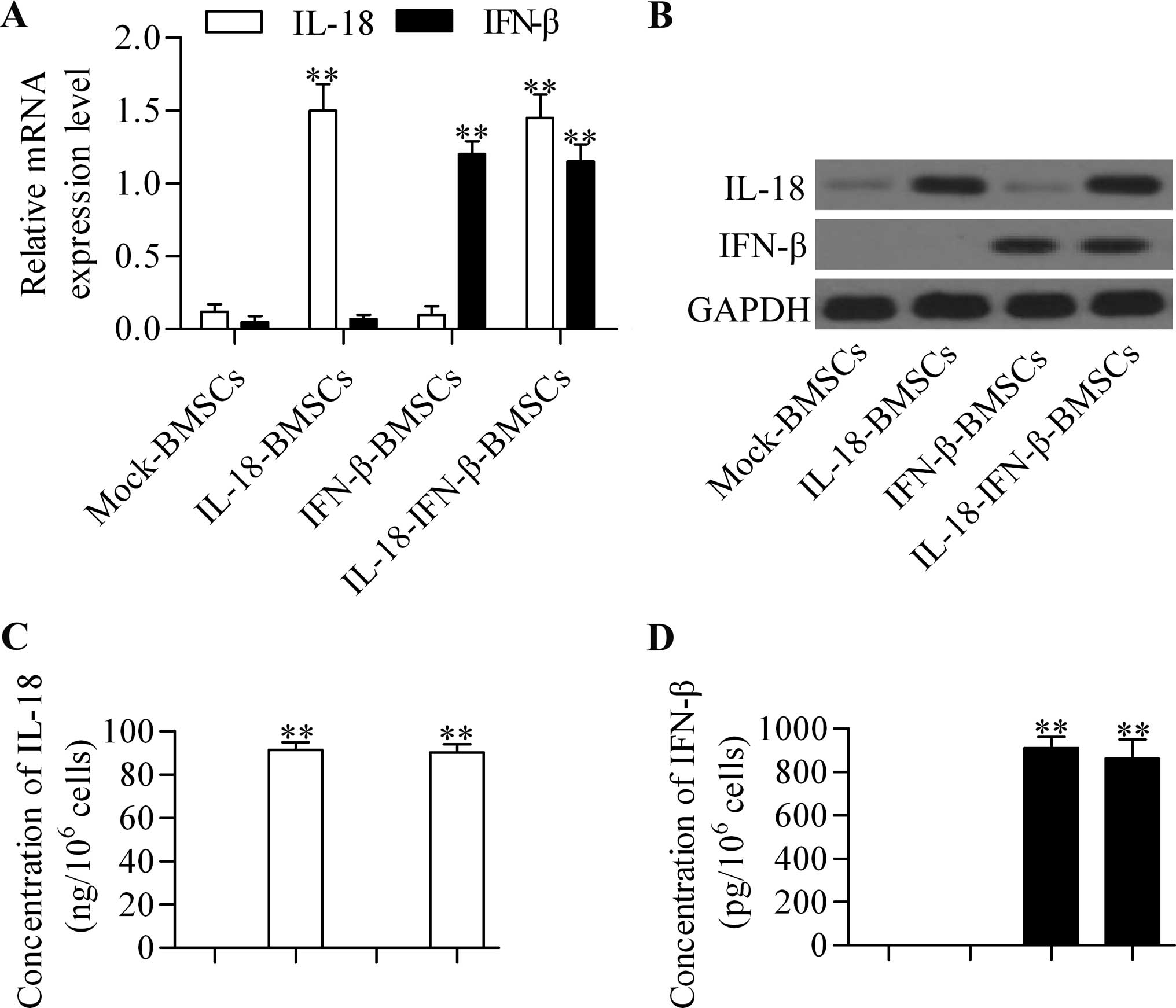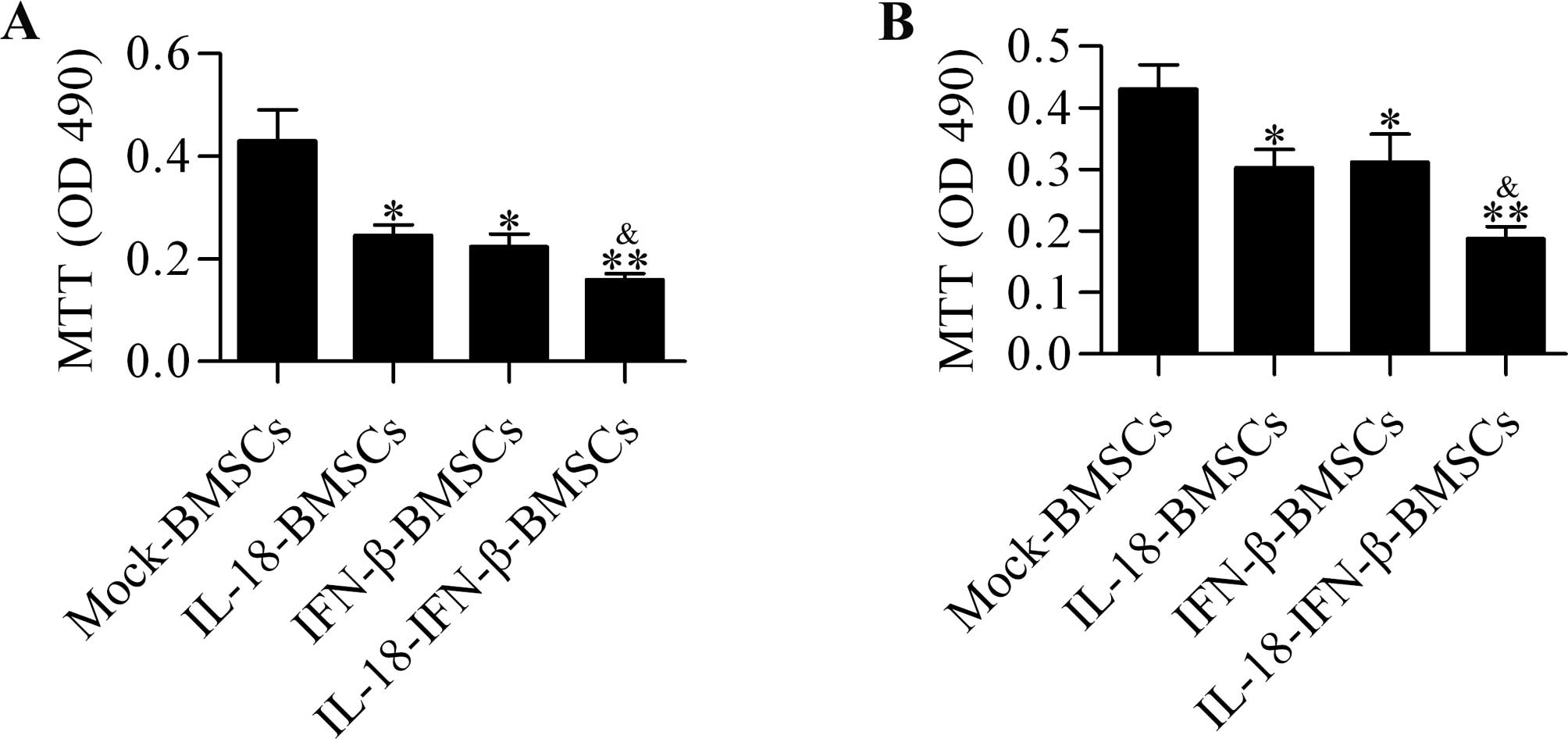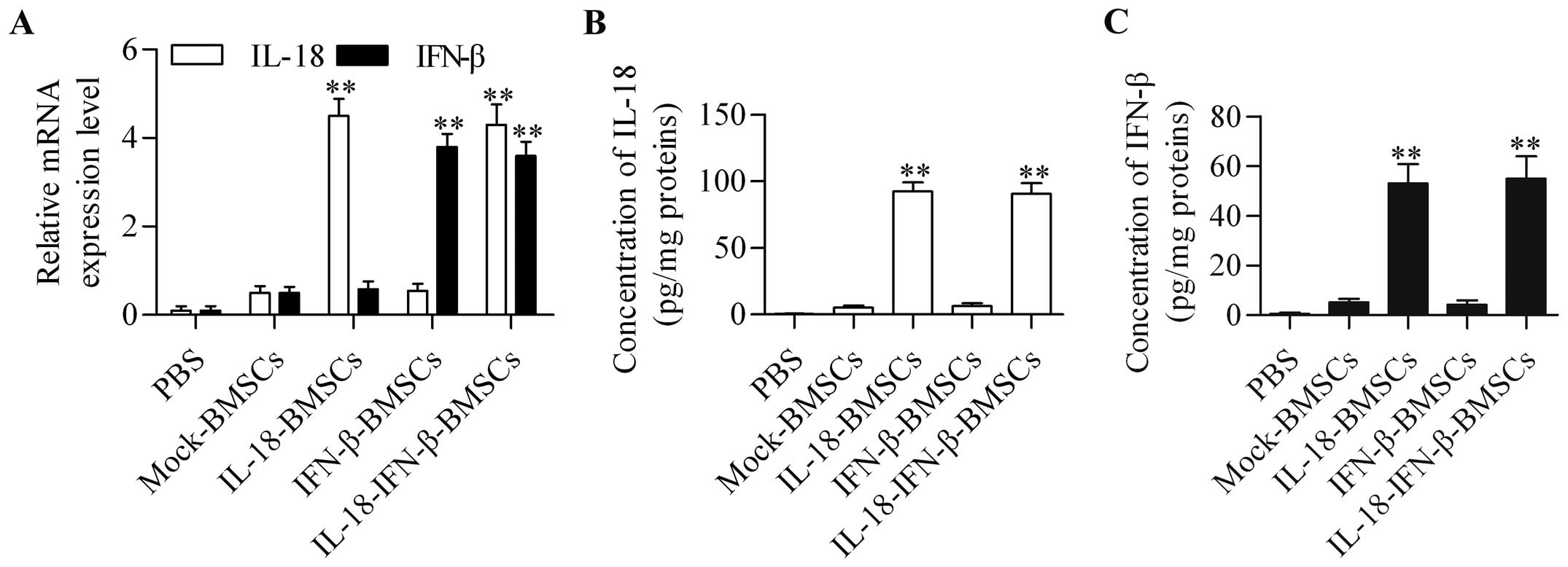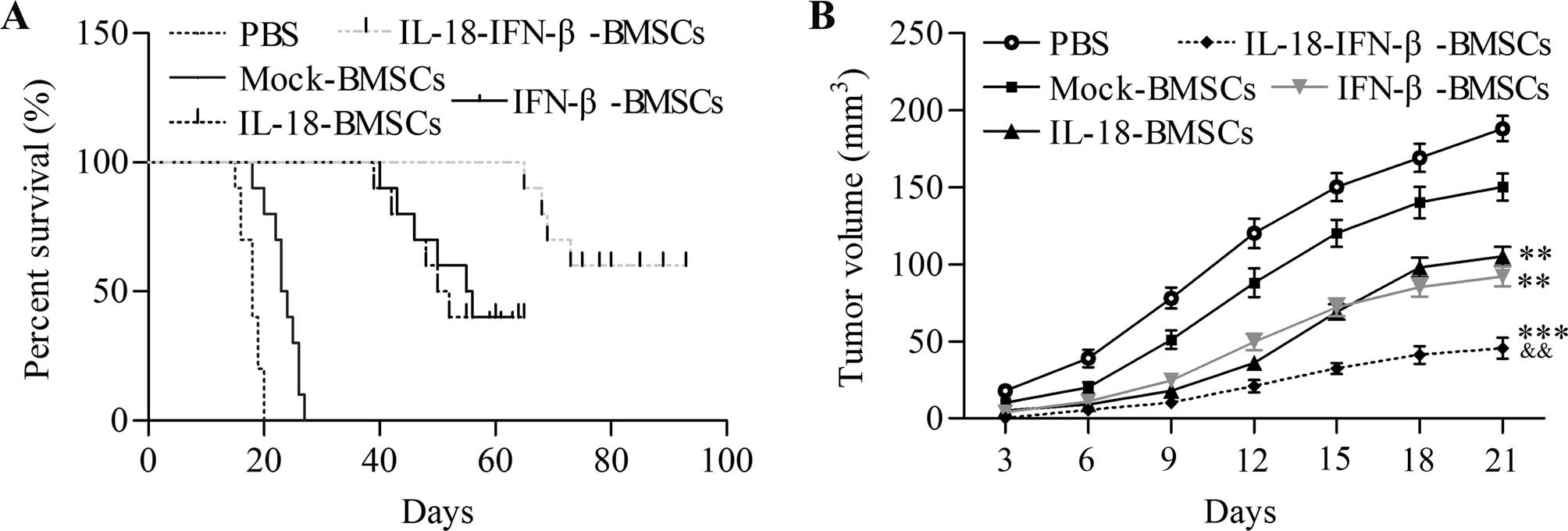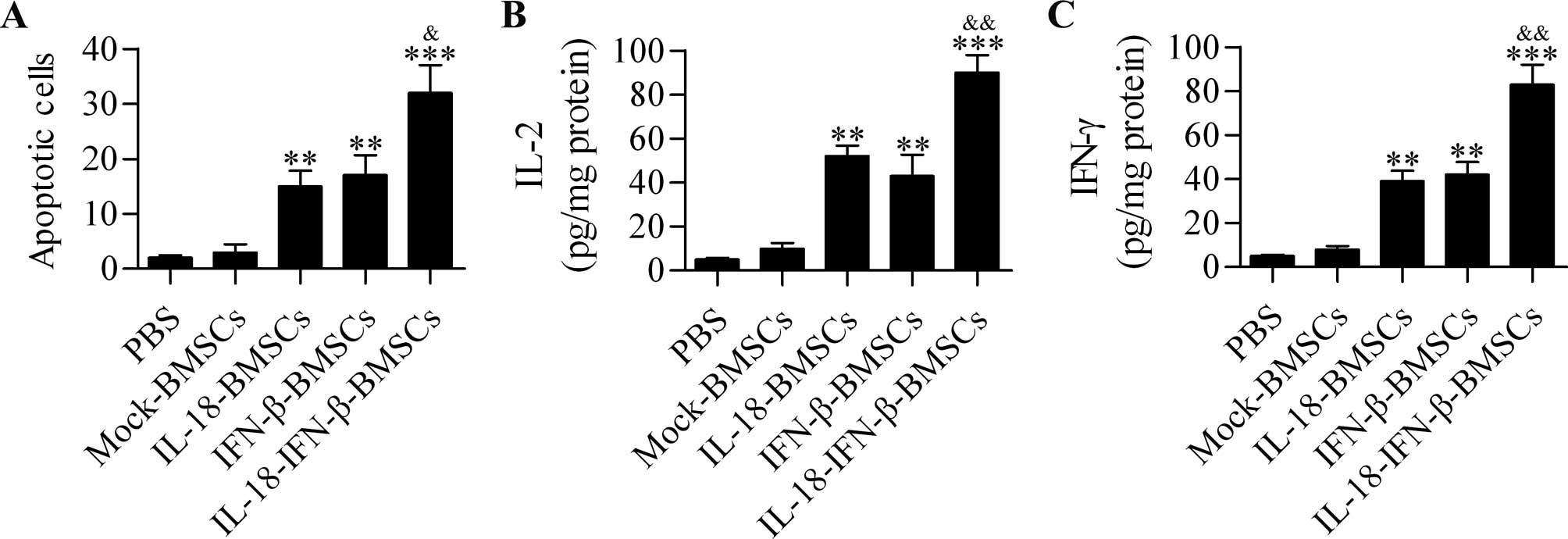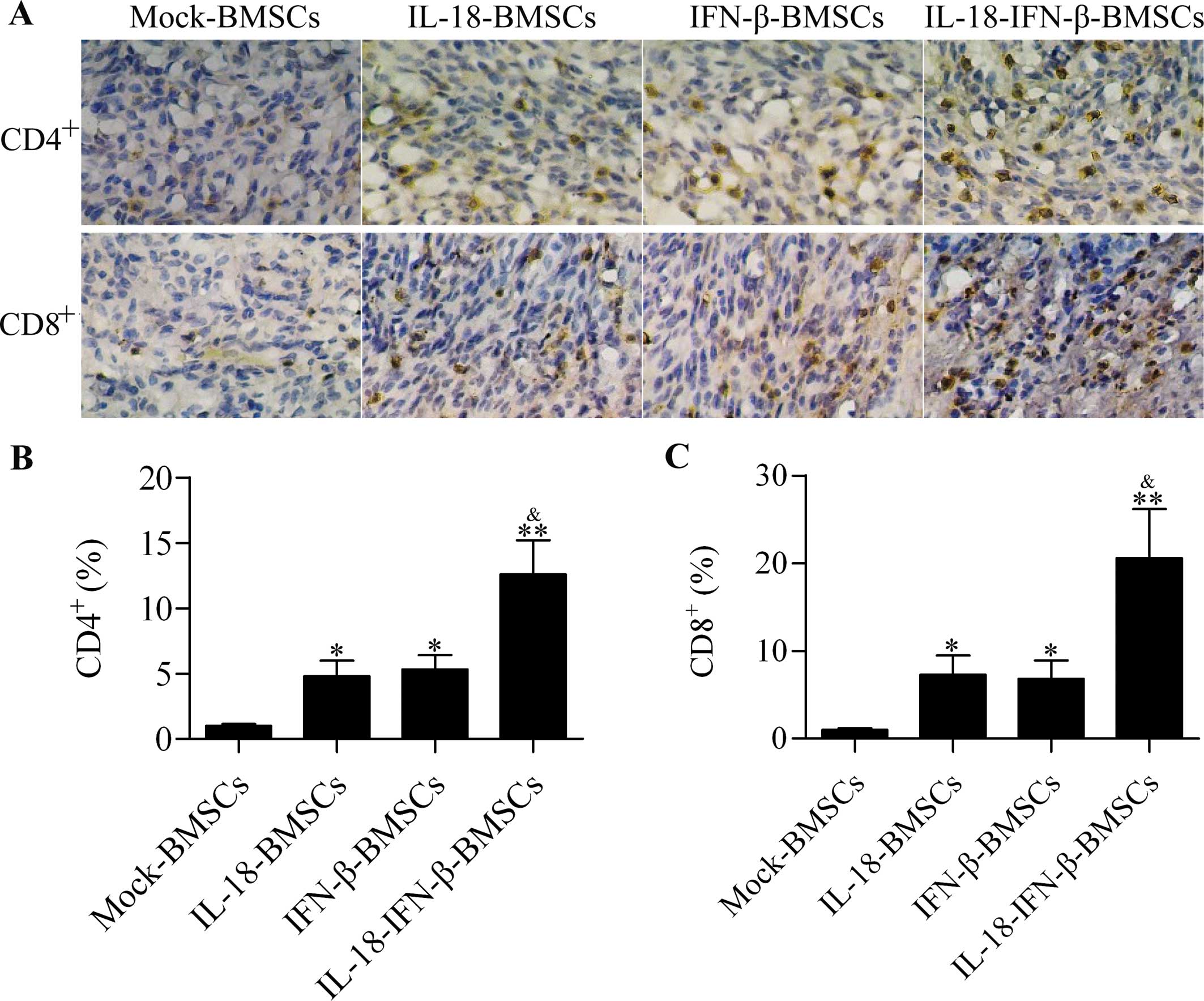Bone marrow-derived mesenchymal stem cells co‑expressing interleukin-18 and interferon-β exhibit potent antitumor effect against intracranial glioma in rats
- Authors:
- Published online on: August 5, 2015 https://doi.org/10.3892/or.2015.4174
- Pages: 1915-1922
Abstract
Introduction
Glioma, which is refractory to tumor therapies with high mortality and morbidity worldwide, is the most frequent intracranial tumor in humans (1,2). Despite the improvement in treatment technology, the disease still has a poor prognosis and survival rate (3). Thereby, developing effective treatment methods is necessary. The lack of sufficient vehicles that specifically target glioma in the brain limits the development of effective therapies. In recent years, bone marrow-derived mesenchymal stem cells (BMSCs) were found to possess selective tumor-tropic properties, which can migrate throughout the experimental brain tumors (4). BMSCs were proposed as a novel cellular vehicles for local delivery of drugs or biological agents to gliomas due to their specific glioma tropism (5,6). Therefore, BMSCs are promising gene vehicles for the treatment of gliomas.
The brain is an immune-privileged site that lacks lymphatic drainage due to the blood-brain barrier, which accelerates the development and progression of gliomas. Immunotherapy for the treatment of glioma has been reported (7). Interleukin (IL)-18 with a molecular weight of 18.3 kDa is a member of IL family that specifically induces Th1 cytokine production, particularly interferon (IFN)-γ from T cells and natural killer cells (8,9). IL-18 activates cytotoxic T activity, augment T cell proliferation, enhance natural killer cytolytic activity and promote antigen presentation (10–12). Furthermore, IL-18 induces the production of IL-2, which has significant antitumor activity against experimental and clinical model of glioma (13,14). Thereby, IL-18 has been proposed as potential immunomodulator for the treatment of malignant gliomas. IFNs containing IFN-α, IFN-β and IFN-γ are a family of natural glycoproteins that activate immune cells, including macrophages, T cells and natural killer cells augmenting antitumor immunity and inhibiting oncogene expression and tumor angiogenesis (15–17). Of these IFNs, IFN-β has been widely studied in the treatment of tumors. This glycoprotein displays potent antiproliferative activity against melanoma cells (18). IFN-β also has a direct cytotoxic effect on glioma cells, and the intratumoral IFN-β delivery significantly enhances the cytotoxic T and natural killer activity without any side-effect (19,20).
In summary, BMSCs possess specific glioma-tropic properties, which are ideal vehicles for gene therapy of gliomas. Our previous study demonstrated that IL-18-expressing BMSCs effectively inhibits intracranial glioma in rats in vivo (21). Considering the vital function of IFN-β in inhibiting tumor growth, we speculated that the co-expression of IL-18 and IFN-β displays more potent and effective antitumor effect against glioma. To test this hypothesis, we constructed a recombinant lentivirus co-expressing IL-18 and IFN-β, which was then introduced into BMSCs to engineer the BMSCs genetically to express both IL-18 and IFN-β. In the present study, we explored the effect of these engineered BMSCs in glioma treatment in vitro and in vivo in a rat intracranial glioma model.
Materials and methods
Experimental animals
Adult male Fisher 344 rats (9–11 weeks old, weighing 180–220 g) were purchased from Gongdong Medical Laboratory Animal Center (Guangzhou, China) and housed in the animal care facility under standard protocols. All animal procedures were conducted according to the institutional and the national guidelines approved by the Institutional Animal Care and Use Committee of Xi'an Jiaotong University.
Cell cultures
Rat 9L glioma cells were obtained from American Type Culture Collection (ATCC; Manassas, VA, USA) and grown in Dulbecco's modified Eagle's medium (DMEM; Invitrogen, Carlsbad, CA, USA) supplemented with 10% fetal bovine serum (FBS; Invitrogen), 2 mM L-glutamine, and 1% streptomycin and penicillin. 293FT cells (Invitrogen) were maintained in DMEM containing 10% fetal calf serum and 1% streptomycin and penicillin. Primary rat BMSCs were isolated and cultured as described in our previous study (21). Fisher 344 rats were sacrificed via intraperitoneal injection of 10% chloral hydrate (0.4 ml/100 g). The femurs and tibias were isolated, and the medullary cavity was flushed with 5 ml of DMEM, followed by density gradient centrifugation (Ficoll-Paque; BD Biosciences, Lincoln Park, NJ, USA) at 2,000 rpm for 15 min. The mononuclear cells were then harvested and resuspended in low glucose DMEM supplemented with 15% FBS, 2 mM L-glutamine and 1% streptomycin and penicillin. All these cells were cultured in a humidified incubator containing 5% CO2 at 37°C.
Recombinant lentivirus construction and infection
The full length cDNAs of IL-18 and IFN-β were amplified using pCR3.1-IL-18 (New England Biolabs, Beverly, MA, USA) and Ad-CMV-IFN-β (provided by the Department of Microbiology, The Second Military Medical University, Shanghai, China), respectively. These cDNA fragments were subcloned into the lentiviral vector pLenti6/V5-DEST to construct the recombinant vectors pLenti6/V5-DEST-IL-18, pLenti6/V5-DEST-IFN-β or pLenti6/V5-DEST-IL-18-IFN-β. These vectors were packaged using ViraPower™ Lentiviral Expression Systems (Invitrogen) according to the manufacturer's instruction. After transfection with 293FT cells for 48–72 h, the culture medium was harvested and filtered using a 0.45 µm filter (Amicon Ultra-15 100K; Millipore, Billerica, MA, USA). These recombinant lentivirus were named LV-IL-18, LV-IFN-β and LV-IL-18-IFN-β, respectively. For infection, BMSCs were seeded into 24-well tissue plates at 1×106 cells/well for 24 h. Subsequently, the lentiviral super-natants were added and incubated for 24 h. Stable clones were selected with Blasticidin S (Invitrogen). These genetically engineered BMSCs were named BMSCs-IL-18, BMSCs-IFN-β and BMSCs-IL-18-IFN-β.
Quantitative real-time PCR (qRT-PCR)
The total RNA extracted using total RNA extraction system (Qiagen, Dusseldorf, Germany) was reversely transcripted into cDNA using M-MLV reverse transcriptase (Clontech, Palo Alto, CA, USA) according to the manufacturer's instruction. qRT-PCR was performed with SYBR-Green PCR master mix (Invitrogen) on a PTC-100 DNA thermal cycler (MG Research, Waltham, MA, USA). Glyceraldehyde-3-phosphate dehydro-genase (GAPDH) was used as an internal reference for the quantification of the relative mRNA expression.
Western blot analysis
Equal amounts of proteins from different samples were loaded on 12.5% SDS-PAGE, separated and transferred to nitrocellulose membranes (Miltenyi Biotec, Auburn, CA, USA). The membranes were blocked with non-fat milk and then incubated with primary antibodies at 4°C overnight. Subsequently, secondary antibodies coupled with horseradish peroxidase (Bioss, Beijing, China) were added for 1 h at room temperature. The immunoreactive proteins were detected using an enhanced chemiluminescence reagent (GE Healthcare, Piscataway, NJ, USA). Primary antibodies, including anti-IL-18, anti-IFN-β and anti-GAPDH were purchased from Santa Cruz Biotechnology (Santa Cruz, CA, USA).
Enzyme-linked immunosorbent assay (ELISA)
The concentrations of IL-18, IFN-β, IFN-γ and IL-2 in the cell cultured medium or tumor tissues were measured using commercial ELISA kits (R&D Systems, Minneapolis, MN, USA) according to the manufacturer's instructions.
Cell viability assay
Cell viability was detected by 3-(4,5-dimethylthiazol-2-yl)-2,5-diphenyltetrazolium bromide (MTT) assay. In brief, 9L cells were seeded into 96-well plates co-cultured with different genetically engineered BMSCs or collected cell culture medium for 24 and 48 h. After replacement with fresh medium, 20 µl of MTT [0.5 mg/ml in phosphate-buffered saline (PBS)] was added per well and incubated for 4 h. The medium was discarded and dimethyl-sulfoxide (150 µl/well) was added to melt the formazan for 15 min. Absorbance was then determined at 450 nm.
Intracranial tumor implantation and treatment
Rat 9L glioma cells were stereotactically implanted into the rat brain according to previously described methods with minor modification (22,23). In brief, rats were anesthetized and placed in a stereotactic frame. The glioma cells (1×106) resuspended into 10 µl of PBS were stereotactically injected into the right corpus striatum with a Hamilton syringe at a depth of 5 mm. Three days after 9L cell implantation, the rats were treated with intratumoral inoculations of 1×106 BMSCs, BMSCs-IL-18, BMSCs-IFN-β and BMSCs-IL-18-IFN-β resuspended into 10 µl of PBS. The tumor volume was monitored using a 1.5 T MRI system (General Electric, Syracuse, NY, USA) with 3-inch surface coil every four days for four weeks. Tumor volumes (mm2) were calculated as follows: (3/4π x length × width × height) × 1/8.
Immunohistochemical staining
After two weeks of treatment, brain tumor tissues were removed from the rats, fixed in 4% paraformaldehyde, dehydrated, frozen and serially cut into 10-µm thick sections using a cryostat microtome. The sections were then incubated with anti-CD4 and anti-CD8 monoclonal antibodies (Abcam, Cambridge, UK). Immunostaining was performed using the avidin-biotin complex method with DAB color development.
Terminal deoxynucleotidyl transferase dUTP nick end labeling (TUNEL) assay
Brain tumor tissue sections were stained using the TUNEL apoptosis kit (GenMed Scientifics, Inc., Arlinghton, MA, USA) according to the manufacturer's instructions. In brief, cells were fixed with 4% paraformaldehyde and incubated with TUNEL reaction mixtures at 37°C for 1 h. The stained cells were visualized and counted under a fluorescence microscope (Olympus, Tokyo, Japan). The number of apoptotic cells was counted in random fields in a blinded manner.
Statistical analysis
Data are expressed as means ± standard deviation. One-way ANOVA was carried with SPSS software package version 11.5 (SPSS, Inc., Chicago, IL, USA) to analyze statistical differences. The survival curve was calculated with the Kaplan-Meier method. p<0.05 was considered to indicate a statistically significant result.
Results
Stable expression of IL-18 and IFN-β in engineered BMSCs
To detect whether IL-18 and IFN-β were successfully introduced into BMSCs, we detected their gene expressions in these engineered BMSCs. The results of qRT-PCR and western blot analysis showed that the IL-18 and IFN-β were expressed in IL-18-BMSCs and IFN-β-BMSCs, respectively, at the mRNA (Fig. 1A) and protein (Fig. 1B) levels. Moreover, co-expression of IL-18 and IFN-β occurred in IL-18-IFN-β-BMSCs. We also examined the secretion levels of these proteins in conditioned media by ELISA method. The results exhibited that soluble IL-18 (Fig. 1C) and IFN-β (Fig. 1D) were detectable in the supernatants from IL-18-BMSCs and IFN-β-BMSCs, respectively, whereas both IL-18 and IFN-β were detected in the supernatants from IL-18-IFN-β-BMSCs. These data indicated that the engineered BMSCs were successfully established.
IL-18-IFN-β-BMSCs significantly inhibit the growth of glioma cells in vitro
To determine the effect of these engineered BMSCs on glioma cell growth, we performed the MTT assay. The results showed that IL-18-BMSCs and IFN-β-BMSCs affected the viability of glioma cells, but IL-18-IFN-β-BMSCs showed more significant inhibitory effect compared with IL-18-BMSCs or IFN-β-BMSCs (Fig. 2A). Moreover, conditioned media from IL-18-IFN-β-BMSCs displayed more potent inhibiting effect on cell viability than those from IL-18-BMSCs or IFN-β-BMSCs (Fig. 2B). These results indicated that the IL-18 and IFN-β secreted from these engineered BMSCs were bioactive.
Treatment with IL-18-IFN-β-BMSCs significantly prolongs survival and represses intracranial glioma growth
To determine whether IL-18-IFN-β-BMSCs provided an effective therapeutic benefit against intracranial glioma growth, these engineered BMSCs were delivered into established intracranial gliomas in a rat model. The results showed that IL-18-IFN-β-BMSCs expressed both high mRNA (Fig. 3A) and secreted protein levels of IL-18 and IFN-β (Fig. 3B and C) in the tumor mass compared with other groups. We also found that IL-18-IFN-β-BMSC treatment significantly prolonged the survival compared with IL-18-BMSC- and IFN-β-BMSC-treated groups (Fig. 4A). Furthermore, their effect on tumor volume was assessed. IL-18-IFN-β-BMSC treatment showed great inhibition of tumor growth when compared with other treatment groups (Fig. 4B).
IL-18-IFN-β-BMSCs induce potent glioma cell apoptosis
To assess apoptosis induction by different engineered BMSCs, apoptotic cells in tumors were identified by the TUNEL assay after treatment. The quantitative data indicated that IL-18-BMSC and IFN-β-BMSC treatments induced considerable cell apoptosis compared with the control group, whereas IL-18-IFN-β-BMSCs induced tumor cell apoptosis more potently than the other groups (Fig. 5A).
IL-18-IFN-β-BMSCs induce strong production of IL-2 and IFN-γ
To further verify that IL-18-IFN-β-BMSCs potentiated strong antitumor effect, we detected the expression of IL-2 and IFN-γ, which were closely related producing anti-tumor effect (24) in tumor tissues with ELISA method. The tumor tissues from IL-18-BMSC- or IFN-β-BMSC-treated rats displayed higher levels of IL-2 and IFN-γ than those from the control group. Significant differences were also observed between rats treated with IL-18-IFN-β-BMSCs and IL-18-BMSCs or IFN-β-BMSCs (Fig. 5B and C).
IL-18-IFN-β-BMSCs induces enhanced CD4+ and CD8+ T-cell infiltration in intracranial glioma
Tumor-infiltrating T cells in glioma patient are beneficial for prolonging survival (25,26). Negligible CD4+ and CD8+ T-cell infiltrations were observed in mock-BMSC-treated groups. A certain degree of tumor-infiltrating CD4+ and CD8+ T cells was also found in animals receiving IL-18-BMSCs or IFN-β-BMSCs treatment. IL-18-IFN-β-BMSC treatments induced more robust CD4+ and CD8+ T-cell infiltration in intracranial glioma than the other groups (Fig. 6A–C).
Discussion
The use of BMSCs as a gene transfer vehicle in the treatment of BMSCs has been extensively investigated (27). BMSCs expressing herpes simplex virus-thymidine kinase suppress glioma tumor growth in a mouse model (28). BMSCs expressing soluble tumor necrosis factor-related apoptosis-inducing ligand (TRAIL) induce substantial tumor cell apoptosis in intracra-nial glioma in a mouse model and significantly improve the survival rate (29). Moreover, TRAIL-engineered BMSCs exhibit cytotoxic effects on glioma cells in vitro (30). In the present study, we demonstrated that BMSCs co-expressing IL-18 and IFN-β displayed a more potent antitumor effect than BMSCs solely expressing IL-18 or IFN-β. This result implies a significant synergistic effect of IL-18 and IFN-β in glioma treatment. The present study, not only confirmed that BMSCs served as a powerful delivery vehicle for glioma treatment, but also provided novel insight for the improvement of glioma gene therapy using BMSCs.
Overexpression of IL-18 induces cell apoptosis of human tongue squamous cell carcinoma cells (31) by regulating glycogen synthase kinase-3β signaling (32). Adenovirus-mediated expression of IL-18 induces significant cell apoptosis and inhibits angiogenesis against melanoma in mice (33). In addition, IFN-β inhibits the proliferation and angiogenesis of malignant glioma cells (34) and displays potent antiproliferative activity against melanoma and glioma cells (18,35,36). In the present study, we found that IL-18-BMSCs or IFN-β-BMSCs successfully expressed IL-18 or IFN-β and significantly inhibited the cell growth of glioma cells. Furthermore, the condition medium from these cultured cells also inhibited cell growth of glioma cells, thus implying that the secreted IL-18 or IFN-β from engineered BMSCs was bioactive. Surprisingly, IL-18-IFN-β-BMSCs co-expressing IL-18 or IFN-β exhibited a more significant growth inhibition on glioma cells than those solely expressing BMSCs. These data suggest that combined IL-18 and IFN-β treatment may have potent antitumor effect on glioma. Similarly, co-expression of IL-18 and Fas enhanced the apoptosis of glioma cells (37). Thereby, the combined utilization of antitumor drugs or biological agents may produce more satisfactory antitumor effect.
The sole use of IL-18 or IFN-β as immunostimulatory cytokine in the treatment of various types of cancers, including gliomas, has been widely studied reporting that IL-18 is a powerful adjuvant for immunotherapy and vaccine therapy and is safe for clinical use (38,39). Intracerebral injection of recombinant IL-18 inhibits the gliomas located in the mouse brain (40), whereas intramuscular injection promotes antigen-specific immune responses mediated by CD4+/CD8+ T cells against brain tumors (41). The glioma cells co-expression of IL-18 and Fas shows reduced tumorigenicity (37). Dendritic cells loaded with tumor lysates and IL-18 elicit CD8+ cytotoxic T cell response against glioma in patients (42). Similarly, dendritic cells that are genetically engineered to express IL-18 combined with the administration of IL-12 significantly induce tumor-specific CD4+/CD8+ T cells and natural killer cells against glioma cells (43). Treatment of adeno-associated virus encoding human IFN-β completely prevents tumor growth and improves the survival of glioma mouse model (44,45). Co-administration of IFN-β and dendritic cells accelerates cell apoptosis and induces specific T-cell responses against glioma cell (16). The intratumoral injection of liposomes containing IFN-β reduces tumor growth and induces massive T cell infiltration within the residual tumor (19). To date, the gene transfer of IL-18 or IFN-β using BMSCs has rarely been investigated. In our previous study, we demonstrated that adenoviral-mediated IL-18 expression in BMSCs effectively suppressed the growth of glioma in rats (21), thereby providing a promising new treatment option for malignant glioma. In the present study, we investigated the treatment effect of the BMSCs co-expression of IL-18 or IFN-β on glioma. The data demonstrated that this co-expression displayed more signifi-cant inhibition effect on glioma, including prolonged survival and reduced tumor growth in intracranial glioma in rats, compared with BMSCs solely expressing IL-18 or IFN-β. The underlying mechanism may be that IL-18 and IFN-β synergistically promoted antitumor immunity, in which antitumor cytokines IL-2 and IFN-γ production and CD4+ and CD8+ T-cell infiltration in intracranial glioma were significantly promoted.
The present study is the first to investigate the effect of BMSCs that were genetically engineered with IL-18 and IFN-β for the treatment of experimental glioma in a rat model. We found that BMSCs co-expressing IL-18 and IFN-β significantly induced cell apoptosis, prolonged survival and reduced tumor growth of intracranial glioma. Their co-expression elicits more potent antitumor immune response than BMSCs solely expressing IL-18 or IFN-β. Our results suggested that delivery of IL-18 and IFN-β by BMSCs may be an excellent and promising approach for the development of an effective treatment protocol for glioma therapy.
Acknowledgments
The present study was supported by the Natural Science Foundation of Shaanxi Province of China (no. 2014JM2-8179).
Abbreviations:
|
BMSCs |
bone marrow-derived mesenchymal stem cells |
|
IL-18 |
interleukin-18 |
|
IFN-β |
interferon-β |
References
|
Mao XG, Zhang X and Zhen HN: Progress on potential strategies to target brain tumor stem cells. Cell Mol Neurobiol. 29:141–155. 2009. View Article : Google Scholar | |
|
Maher EA, Furnari FB, Bachoo RM, Rowitch DH, Louis DN, Cavenee WK and DePinho RA: Malignant glioma: Genetics and biology of a grave matter. Genes Dev. 15:1311–1333. 2001. View Article : Google Scholar : PubMed/NCBI | |
|
Sanai N and Berger MS: Glioma extent of resection and its impact on patient outcome. Neurosurgery. 62:753–764; discussion 264–266. 2008. View Article : Google Scholar : PubMed/NCBI | |
|
Bexell D, Gunnarsson S, Tormin A, Darabi A, Gisselsson D, Roybon L, Scheding S and Bengzon J: Bone marrow multipotent mesenchymal stroma cells act as pericyte-like migratory vehicles in experimental gliomas. Mol Ther. 17:183–190. 2009. View Article : Google Scholar | |
|
Gunnarsson S, Bexell D, Svensson A, Siesjö P, Darabi A and Bengzon J: Intratumoral IL-7 delivery by mesenchymal stromal cells potentiates IFNgamma-transduced tumor cell immuno-therapy of experimental glioma. J Neuroimmunol. 218:140–144. 2010. View Article : Google Scholar | |
|
Matuskova M, Hlubinova K, Pastorakova A, Hunakova L, Altanerova V, Altaner C and Kucerova L: HSV-tk expressing mesenchymal stem cells exert bystander effect on human glio-blastoma cells. Cancer Lett. 290:58–67. 2010. View Article : Google Scholar | |
|
Suryadevara CM, Verla T, Sanchez-Perez L, Reap EA, Choi BD, Fecci PE and Sampson JH: Immunotherapy for malignant glioma. Surg Neurol Int. 6(Suppl 1): S68–S77. 2015. View Article : Google Scholar : PubMed/NCBI | |
|
Okamura H, Tsutsi H, Komatsu T, Yutsudo M, Hakura A, Tanimoto T, Torigoe K, Okura T, Nukada Y, Hattori K, et al: Cloning of a new cytokine that induces IFN-gamma production by T cells. Nature. 378:88–91. 1995. View Article : Google Scholar : PubMed/NCBI | |
|
Hwang KS, Cho WK, Yoo J, Seong YR, Kim BK, Kim S and Im DS: Adenovirus-mediated interleukin-18 mutant in vivo gene transfer inhibits tumor growth through the induction of T cell immunity and activation of natural killer cell cytotoxicity. Cancer Gene Ther. 11:397–407. 2004. View Article : Google Scholar : PubMed/NCBI | |
|
Ossendorp F, Mengedé E, Camps M, Filius R and Melief CJ: Specific T helper cell requirement for optimal induction of cytotoxic T lymphocytes against major histocompatibility complex class II negative tumors. J Exp Med. 187:693–702. 1998. View Article : Google Scholar : PubMed/NCBI | |
|
Kohyama M, Saijyo K, Hayasida M, Yasugi T, Kurimoto M and Ohno T: Direct activation of human CD8+ cytotoxic T lymphocytes by interleukin-18. Jpn J Cancer Res. 89:1041–1046. 1998. View Article : Google Scholar : PubMed/NCBI | |
|
Xia D, Li F and Xiang J: Engineered fusion hybrid vaccine of IL-18 gene-modified tumor cells and dendritic cells induces enhanced antitumor immunity. Cancer Biother Radiopharm. 19:322–330. 2004. View Article : Google Scholar : PubMed/NCBI | |
|
Glick RP, Lichtor T, Mogharbel A, Taylor CA and Cohen EP: Intracerebral versus subcutaneous immunization with allogeneic fibroblasts genetically engineered to secrete interleukin-2 in the treatment of central nervous system glioma and melanoma. Neurosurgery. 41:898–906; discussion 906–907. 1997. View Article : Google Scholar : PubMed/NCBI | |
|
Sobol RE, Fakhrai H, Shawler D, Gjerset R, Dorigo O, Carson C, Khaleghi T, Koziol J, Shiftan TA and Royston I: Interleukin-2 gene therapy in a patient with glioblastoma. Gene Ther. 2:164–167. 1995.PubMed/NCBI | |
|
Hertzog PJ, Hwang SY and Kola I: Role of interferons in the regulation of cell proliferation, differentiation, and development. Mol Reprod Dev. 39:226–232. 1994. View Article : Google Scholar : PubMed/NCBI | |
|
Nakahara N, Pollack IF, Storkus WJ, Wakabayashi T, Yoshida J and Okada H: Effective induction of antiglioma cytotoxic T cells by coadministration of interferon-beta gene vector and dendritic cells. Cancer Gene Ther. 10:549–558. 2003. View Article : Google Scholar : PubMed/NCBI | |
|
Williams RF, Myers AL, Sims TL, Ng CY, Nathwani AC and Davidoff AM: Targeting multiple angiogenic pathways for the treatment of neuroblastoma. J Pediatr Surg. 45:1103–1109. 2010. View Article : Google Scholar : PubMed/NCBI | |
|
Kageshita T, Mizuno M, Ono T, Matsumoto K, Saida T and Yoshida J: Growth inhibition of human malignant melanoma transfected with the human interferon-beta gene by means of cationic liposomes. Melanoma Res. 11:337–342. 2001. View Article : Google Scholar : PubMed/NCBI | |
|
Natsume A, Mizuno M, Ryuke Y and Yoshida J: Antitumor effect and cellular immunity activation by murine interferon-beta gene transfer against intracerebral glioma in mouse. Gene Ther. 6:1626–1633. 1999. View Article : Google Scholar : PubMed/NCBI | |
|
Natsume A, Tsujimura K, Mizuno M, Takahashi T and Yoshida J: IFN-beta gene therapy induces systemic antitumor immunity against malignant glioma. J Neurooncol. 47:117–124. 2000. View Article : Google Scholar : PubMed/NCBI | |
|
Xu G, Jiang XD, Xu Y, Zhang J, Huang FH, Chen ZZ, Zhou DX, Shang JH, Zou YX and Cai YQ: Adenoviral-mediated interleukin-18 expression in mesenchymal stem cells effectively suppresses the growth of glioma in rats. Cell Biol Int. 33:466–474. 2009. View Article : Google Scholar | |
|
Olson JJ, Friedman R, Orr K, Delaney T and Oldfield EH: Enhancement of the efficacy of x-irradiation by pentobarbital in a rodent brain-tumor model. J Neurosurg. 72:745–748. 1990. View Article : Google Scholar : PubMed/NCBI | |
|
Farrell CL, Stewart PA and Del Maestro RF: A new glioma model in rat: The C6 spheroid implantation technique permeability and vascular characterization. J Neurooncol. 4:403–415. 1987. View Article : Google Scholar : PubMed/NCBI | |
|
Chen W, Wang J, Shao C, Liu S, Yu Y, Wang Q and Cao X: Efficient induction of antitumor T cell immunity by exosomes derived from heat-shocked lymphoma cells. Eur J Immunol. 36:1598–1607. 2006. View Article : Google Scholar : PubMed/NCBI | |
|
Lohr J, Ratliff T, Huppertz A, Ge Y, Dictus C, Ahmadi R, Grau S, Hiraoka N, Eckstein V, Ecker RC, et al: Effector T-cell infiltration positively impacts survival of glioblastoma patients and is impaired by tumor-derived TGF-β. Clin Cancer Res. 17:4296–4308. 2011. View Article : Google Scholar : PubMed/NCBI | |
|
Kraman M, Bambrough PJ, Arnold JN, Roberts EW, Magiera L, Jones JO, Gopinathan A, Tuveson DA and Fearon DT: Suppression of antitumor immunity by stromal cells expressing fibroblast activation protein-alpha. Science. 330:827–830. 2010. View Article : Google Scholar : PubMed/NCBI | |
|
Nakamizo A, Marini F, Amano T, Khan A, Studeny M, Gumin J, Chen J, Hentschel S, Vecil G, Dembinski J, et al: Human bone marrow-derived mesenchymal stem cells in the treatment of gliomas. Cancer Res. 65:3307–3318. 2005.PubMed/NCBI | |
|
Uchibori R, Okada T, Ito T, Urabe M, Mizukami H, Kume A and Ozawa K: Retroviral vector-producing mesenchymal stem cells for targeted suicide cancer gene therapy. J Gene Med. 11:373–381. 2009. View Article : Google Scholar : PubMed/NCBI | |
|
Menon LG, Kelly K, Yang HW, Kim SK, Black PM and Carroll RS: Human bone marrow-derived mesenchymal stromal cells expressing S-TRAIL as a cellular delivery vehicle for human glioma therapy. Stem Cells. 27:2320–2330. 2009. View Article : Google Scholar : PubMed/NCBI | |
|
Tang XJ, Lu JT, Tu HJ, Huang KM, Fu R, Cao G, Huang M, Cheng LH, Dai LJ and Zhang L: TRAIL-engineered bone marrow-derived mesenchymal stem cells: TRAIL expression and cytotoxic effects on C6 glioma cells. Anticancer Res. 34:729–734. 2014.PubMed/NCBI | |
|
Liu W, Han B, Sun B, Gao Y, Huang Y and Hu M: Overexpression of interleukin-18 induces growth inhibition, apoptosis and gene expression changes in a human tongue squamous cell carcinoma cell line. J Int Med Res. 40:537–544. 2012. View Article : Google Scholar : PubMed/NCBI | |
|
Liu W, Hu M, Wang Y, Sun B, Guo Y, Xu Z, Li J and Han B: Overexpression of interleukin-18 protein reduces viability and induces apoptosis of tongue squamous cell carcinoma cells by activation of glycogen synthase kinase-3β signaling. Oncol Rep. 33:1049–1056. 2015.PubMed/NCBI | |
|
Zheng JN, Pei DS, Mao LJ, Liu XY, Sun FH, Zhang BF, Liu YQ, Liu JJ, Li W and Han D: Oncolytic adenovirus expressing interleukin-18 induces significant antitumor effects against melanoma in mice through inhibition of angiogenesis. Cancer Gene Ther. 17:28–36. 2010. View Article : Google Scholar | |
|
Takano S, Ishikawa E, Matsuda M, Yamamoto T and Matsumura A: Interferon-β inhibits glioma angiogenesis through downregulation of vascular endothelial growth factor and upregulation of interferon inducible protein 10. Int J Oncol. 45:1837–1846. 2014.PubMed/NCBI | |
|
Yoshida J, Mizuno M and Yagi K: Cytotoxicity of human beta-interferon produced in human glioma cells transfected with its gene by means of liposomes. Biochem Int. 28:1055–1061. 1992.PubMed/NCBI | |
|
Guo Y, Wang G, Gao WW, Cheng SW, Wang R, Ju SM, Cao HL and Tian HL: Induction of apoptosis in glioma cells and upregulation of Fas expression using the human interferon-β gene. Asian Pac J Cancer Prev. 13:2837–2840. 2012. View Article : Google Scholar | |
|
Zhang Y, Wang C, Zhang Y and Sun M: C6 glioma cells retrovi-rally engineered to express IL-18 and Fas exert FasL-dependent cytotoxicity against glioma formation. Biochem Biophys Res Commun. 325:1240–1245. 2004. View Article : Google Scholar : PubMed/NCBI | |
|
Marshall DJ, Rudnick KA, McCarthy SG, Mateo LR, Harris MC, McCauley C and Snyder LA: Interleukin-18 enhances Th1 immunity and tumor protection of a DNA vaccine. Vaccine. 24:244–253. 2006. View Article : Google Scholar | |
|
Robertson MJ, Mier JW, Logan T, Atkins M, Koon H, Koch KM, Kathman S, Pandite LN, Oei C, Kirby LC, et al: Clinical and biological effects of recombinant human interleukin-18 administered by intravenous infusion to patients with advanced cancer. Clin Cancer Res. 12:4265–4273. 2006. View Article : Google Scholar : PubMed/NCBI | |
|
Kikuchi T, Akasaki Y, Joki T, Abe T, Kurimoto M and Ohno T: Antitumor activity of interleukin-18 on mouse glioma cells. J Immunother. 23:184–189. 2000. View Article : Google Scholar : PubMed/NCBI | |
|
Yamanaka R and Xanthopoulos KG: Induction of antigen-specific immune responses against malignant brain tumors by intramuscular injection of sindbis DNA encoding gp100 and IL-18. DNA Cell Biol. 24:317–324. 2005. View Article : Google Scholar : PubMed/NCBI | |
|
Yamanaka R, Honma J, Tsuchiya N, Yajima N, Kobayashi T and Tanaka R: Tumor lysate and IL-18 loaded dendritic cells elicits Th1 response, tumor-specific CD8+ cytotoxic T cells in patients with malignant glioma. J Neurooncol. 72:107–113. 2005. View Article : Google Scholar : PubMed/NCBI | |
|
Yamanaka R, Tsuchiya N, Yajima N, Honma J, Hasegawa H, Tanaka R, Ramsey J, Blaese RM and Xanthopoulos KG: Induction of an antitumor immunological response by an intratumoral injection of dendritic cells pulsed with genetically engineered Semliki Forest virus to produce interleukin-18 combined with the systemic administration of interleukin-12. J Neurosurg. 99:746–753. 2003. View Article : Google Scholar : PubMed/NCBI | |
|
Meijer DH, Maguire CA, LeRoy SG and Sena-Esteves M: Controlling brain tumor growth by intraventricular administration of an AAV vector encoding IFN-beta. Cancer Gene Ther. 16:664–671. 2009. View Article : Google Scholar : PubMed/NCBI | |
|
Streck CJ, Dickson PV, Ng CY, Zhou J, Hall MM, Gray JT, Nathwani AC and Davidoff AM: Antitumor efficacy of AAV-mediated systemic delivery of interferon-beta. Cancer Gene Ther. 13:99–106. 2006. View Article : Google Scholar |



